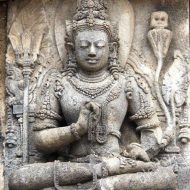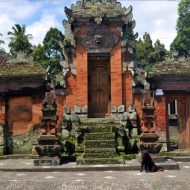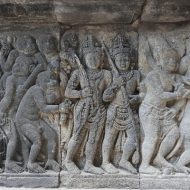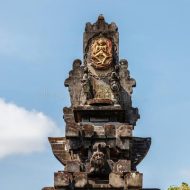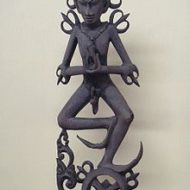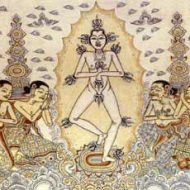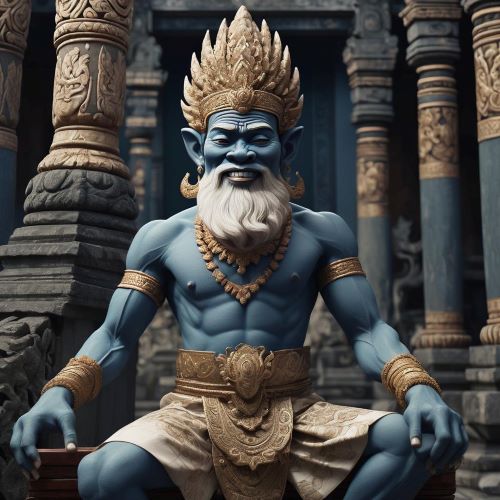Acintya : The Supreme God
Listen
At a glance
| Description | |
|---|---|
| Origin | Indonesian Mythology |
| Classification | Gods |
| Family Members | N/A |
| Region | Bali, Indonesia |
| Associated With | Creation, Supreme Being |
Acintya
Introduction
In Indonesia, Acintya is regarded as the Supreme God, and he is usually worshipped in Bali due to the local culture’s tendency for monism. This deity is similar to Brahman in Indian Hinduism, and he is also featured in traditional wayang, or shadow puppet shows. In Hinduism, all living things are believed to be manifestations of the Acintya in Bali.
Physical Traits
The statues of Acintya feature phallus-like protrusions on the body, which imply that he is regarded as a fertility and sun god. The elegant shape of his body is said to be inspired by the dance form of Shiva. Due to the various vulnerable parts, such as the flaming or phallus shapes, these statues are incredibly hard to carve. In addition, Acintya, who is also referred to as a sun god, is often depicted undressed.
Family
Monism in Bali has led to the belief that there is only one supreme deity, and all other deities are merely manifestations of him. The name Acintya refers to the origin of the universe.
Other names
Acintya is also referred in Balinese to as “Sang Hyang Widhi Wasa”, meaning “The Divine Order”, and “Sang Hyang Tunggal”, translated to “The Divine Oneness”. The name is also often spelled as Achintya.
Powers and Abilities
Similar to Brahman in Indian Hinduism, Acintya is regarded as a deity in Bali. Although he is usually not offered to directly, offerings and prayers are usually made to his other manifestations. He is considered to be omnipotent and having ultimate powers over everything in the universe.
The creation of the Padmasana as a deity altar was the result of a movement carried out during the 16th century. During this time, when Islam was spreading across Java and the western part of Indonesia, Dang Hyang Nirartha established temples in Bali.
Modern Day Influence
Following the end of World War II, Indonesia adopted the Pancasila political philosophy, which allowed for the freedom of religion. However, the statute that governs the establishment of religion also requires that it be monotheistic. This system, which includes various other religions such as Buddhism, Hinduism, Protestantism, and Islam, has been recognized as a religion of universal importance.
To comply with the regulations, the Hindus of Bali had to reinforce the importance of the monotheistic component in their faith. To refer to Acintya, they called him Sang Hyang Widhi wasa, which literally means “God Almighty.” Although this term was used by Protestant missionaries during the 1930s to refer to the Christian god, it was regarded as an acceptable description of the Hindu deity.
Related Images
Frequently Asked Questions
Which God is Achintya?
Achintya is a Sanskrit word that means “inconceivable” or “beyond comprehension”. It is also the name of the supreme god in Balinese Hinduism, who is the source of all existence and manifestation. Achintya is equivalent to Brahman, the ultimate reality in Hindu philosophy.
Who is the supreme god of Bali?
The supreme god of Bali is Achintya, also known as Sang Hyang Widhi Wasa or Sang Hyang Tunggal. He is the ultimate reality and the source of all existence and manifestation. He is equivalent to Brahman, the metaphysical concept of Hinduism. He is not directly worshipped, but through his other manifestations, such as Brahma, Vishnu, and Shiva.
What does Achintya means?
Achintya means “the inconceivable” or “the unimaginable” in Sanskrit. It is a word that describes something that is beyond understanding, thought, or imagination. It is also a Hindu name that is often given to boys. It reflects the idea of the supreme deity who is the origin of everything and cannot be grasped by human mind.
Why did Indonesia modify Hinduism?
The statute that governs the establishment of religion also requires that it be monotheistic. This system, which includes various other religions such as Buddhism, Hinduism, Protestantism, and Islam, has been recognized as a religion of universal importance.

